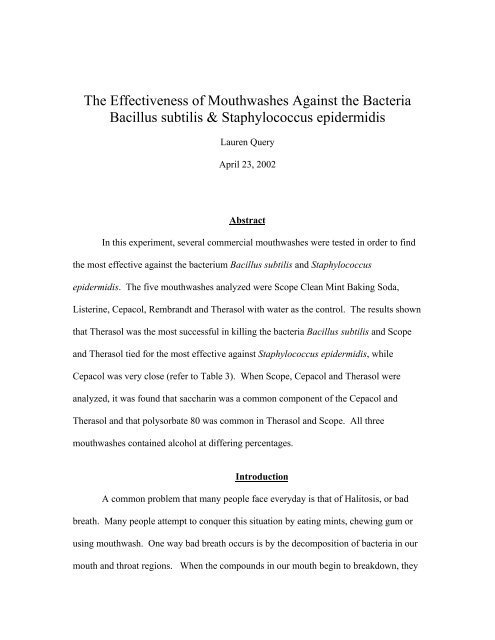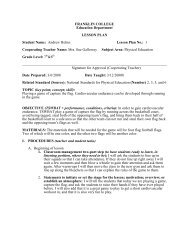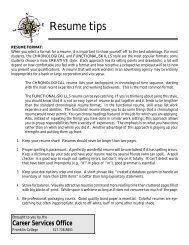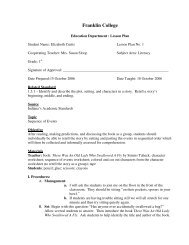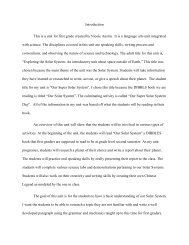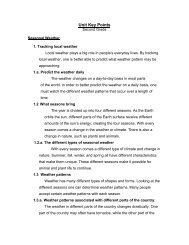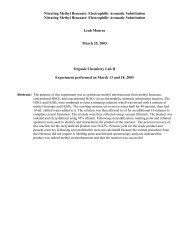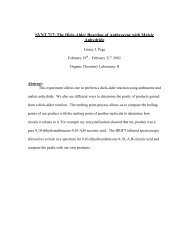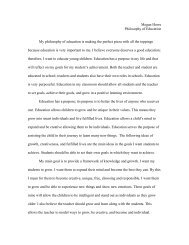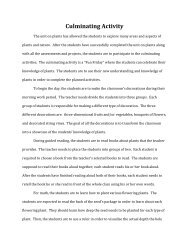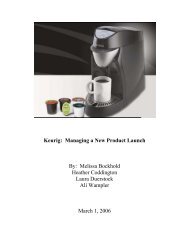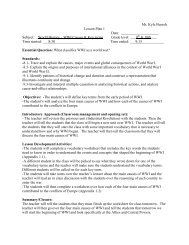The Effectiveness of Mouthwashes Against the ... - Franklin College
The Effectiveness of Mouthwashes Against the ... - Franklin College
The Effectiveness of Mouthwashes Against the ... - Franklin College
Create successful ePaper yourself
Turn your PDF publications into a flip-book with our unique Google optimized e-Paper software.
<strong>The</strong> <strong>Effectiveness</strong> <strong>of</strong> <strong>Mouthwashes</strong> <strong>Against</strong> <strong>the</strong> Bacteria<br />
Bacillus subtilis & Staphylococcus epidermidis<br />
Lauren Query<br />
April 23, 2002<br />
Abstract<br />
In this experiment, several commercial mouthwashes were tested in order to find<br />
<strong>the</strong> most effective against <strong>the</strong> bacterium Bacillus subtilis and Staphylococcus<br />
epidermidis. <strong>The</strong> five mouthwashes analyzed were Scope Clean Mint Baking Soda,<br />
Listerine, Cepacol, Rembrandt and <strong>The</strong>rasol with water as <strong>the</strong> control. <strong>The</strong> results shown<br />
that <strong>The</strong>rasol was <strong>the</strong> most successful in killing <strong>the</strong> bacteria Bacillus subtilis and Scope<br />
and <strong>The</strong>rasol tied for <strong>the</strong> most effective against Staphylococcus epidermidis, while<br />
Cepacol was very close (refer to Table 3). When Scope, Cepacol and <strong>The</strong>rasol were<br />
analyzed, it was found that saccharin was a common component <strong>of</strong> <strong>the</strong> Cepacol and<br />
<strong>The</strong>rasol and that polysorbate 80 was common in <strong>The</strong>rasol and Scope. All three<br />
mouthwashes contained alcohol at differing percentages.<br />
Introduction<br />
A common problem that many people face everyday is that <strong>of</strong> Halitosis, or bad<br />
breath. Many people attempt to conquer this situation by eating mints, chewing gum or<br />
using mouthwash. One way bad breath occurs is by <strong>the</strong> decomposition <strong>of</strong> bacteria in our<br />
mouth and throat regions. When <strong>the</strong> compounds in our mouth begin to breakdown, <strong>the</strong>y
elease sulfides, which are produced by ei<strong>the</strong>r grain negative bacteria or <strong>the</strong> renewal <strong>of</strong><br />
<strong>the</strong> oral mucosa tissue. A bi-product <strong>of</strong> <strong>the</strong> bacteria is hydrogen sulfide gases, which<br />
produce volatile sulfide compounds (VSC) (Halitosis).<br />
<strong>The</strong> question I asked myself was, “Which mouthwash will kill <strong>the</strong> most bacteria?”<br />
My hypo<strong>the</strong>sis for this experiment was that Listerine would inhibit <strong>the</strong> growth <strong>of</strong> <strong>the</strong><br />
most bacteria for <strong>the</strong> reason that when people have <strong>the</strong>ir tongues pierced, <strong>the</strong>y are told to<br />
use Listerine and it contains <strong>the</strong> highest percentage <strong>of</strong> alcohol.<br />
<strong>The</strong> bacteria Bacillus subtilis is commonly found in <strong>the</strong> soil (Foundations in<br />
Microbiology 273). If persons with a weakened immunity obtain Bacillus subtilis <strong>the</strong>y<br />
can get lung and blood infections (Microbiology 507). Bacillus subtilis produces spores,<br />
which are dormant structures that serve as a way <strong>of</strong> reproduction. It is used as a<br />
microbial source for <strong>the</strong> pharmaceutical Bacitracin, which is used as an antibiotic<br />
effective against gram-positive bacteria (Foundations in Microbiology 748).<br />
<strong>The</strong> well-known bacteria Staphylococcus epidermidis is most commonly found in<br />
<strong>the</strong> skin, hair follicles and <strong>the</strong> mucous membranes (Foundations in Microbiology 482). It<br />
is located along <strong>the</strong> nasal passages that are included in <strong>the</strong> normal flora. <strong>The</strong> normal flora<br />
consists <strong>of</strong> <strong>the</strong> microorganisms that develop in <strong>the</strong> interior and exterior portions <strong>of</strong> <strong>the</strong><br />
body without producing obvious harmful effects on <strong>the</strong> tissues (Microbiology 335). <strong>The</strong><br />
genera Staphylococcus principally consists <strong>of</strong> gram-positive cocci and is normally present<br />
on <strong>the</strong> skin (Microbiology 424).<br />
2
Materials & Methods<br />
<strong>The</strong> method <strong>of</strong> this experiment was described in <strong>the</strong> “Microbiology Lab:<br />
Comparison <strong>of</strong> <strong>the</strong> Antibacterial Activity <strong>of</strong> Several <strong>Mouthwashes</strong>” by Dr. Steve<br />
Browder, where <strong>the</strong> bacterium Bacillus subtilis and Staphylococcus epidermidis were<br />
analyzed. An additional handout was given, listing <strong>the</strong> different types <strong>of</strong> mouthwashes to<br />
analyze and <strong>the</strong> components found in <strong>the</strong>m. <strong>The</strong> only test that was not performed was <strong>the</strong><br />
saliva test, which <strong>the</strong> information given was not acknowledged. <strong>The</strong> sterile techniques<br />
that needed to be followed were not included in <strong>the</strong> lab handout. In order to ensure<br />
sterility, <strong>the</strong> pipets were only touched at <strong>the</strong> end that does not come in contact with <strong>the</strong><br />
bacteria. <strong>The</strong> forceps that were used to transfer <strong>the</strong> filter paper disks <strong>of</strong> mouthwash were<br />
first squirted with alcohol to kill any contamination. Also, keep <strong>the</strong> petri dish covered as<br />
much as possible so that no o<strong>the</strong>r bacteria may contaminate <strong>the</strong> petri dish. After mixing<br />
<strong>the</strong> bacteria and <strong>the</strong> agar in a test tube, <strong>the</strong> top <strong>of</strong> <strong>the</strong> tube was run through <strong>the</strong> open flame<br />
<strong>of</strong> a bunson burner to kill any unwanted bacteria.<br />
Results<br />
<strong>The</strong> results found from this experiment are that <strong>The</strong>rasol was <strong>the</strong> most effective<br />
against Bacillus subtilis and inhibited <strong>the</strong> growth by an average <strong>of</strong> 16.5 mm (refer to<br />
Table 3). <strong>The</strong> data resulted in <strong>The</strong>rasol as <strong>the</strong> number one mouthwash, Scope was<br />
number two, and Cepacol and Rembrandt are tied for number three, and Listerine was<br />
number four for Bacillus subtilis.<br />
3
Scope and <strong>The</strong>rasol tied for number one, Cepacol was number two, Rembrandt<br />
was number three, and Listerine was number four for Staphylococcus epidermidis. Scope<br />
had <strong>the</strong> largest inhibition ring <strong>of</strong> 19.5 mm and <strong>The</strong>rasol and Cepacol were close with 16.5<br />
mm and 13.9 mm, respectively (refer to Table 3).<br />
Table 1 lists <strong>the</strong> zone <strong>of</strong> inhibition measured in millimeters for all <strong>the</strong><br />
mouthwashes performed by all <strong>the</strong> groups for Bacillus subtilis. Table 2 shows <strong>the</strong><br />
information for <strong>the</strong> zone <strong>of</strong> inhibition <strong>of</strong> Staphylococcus epidermidis <strong>of</strong> <strong>the</strong> mouthwashes<br />
for all <strong>the</strong> groups. Table 3 represents <strong>the</strong> average growth <strong>of</strong> inhibition for each type <strong>of</strong><br />
mouthwash for both <strong>of</strong> <strong>the</strong> bacteria. To measure <strong>the</strong> growth <strong>of</strong> inhibition, <strong>the</strong> distance<br />
from <strong>the</strong> end <strong>of</strong> <strong>the</strong> mouthwash disk to <strong>the</strong> widest point <strong>of</strong> inhibition was measured using<br />
a ruler in millimeters (mm). It also states <strong>the</strong> standard deviation for each mouthwash for<br />
both <strong>of</strong> <strong>the</strong> bacteria. Table 4 lists <strong>the</strong> tabulated T-values for each mouthwash compared<br />
to one ano<strong>the</strong>r for both <strong>of</strong> <strong>the</strong> bacteria. It also shows <strong>the</strong> degrees <strong>of</strong> freedom at <strong>the</strong> 95%,<br />
99% and 99.9% confidence levels.<br />
Graph 1 illustrates <strong>the</strong> mean for zone <strong>of</strong> inhibition for each type <strong>of</strong> mouthwash for<br />
Bacillus subtilis. Graph 2 represents <strong>the</strong> mean for zone <strong>of</strong> inhibition for <strong>the</strong>y different<br />
types <strong>of</strong> mouthwashes for Staphylococcus epidermidis.<br />
Discussion<br />
After <strong>the</strong> data was analyzed, <strong>the</strong> results did not represent <strong>the</strong> initial hypo<strong>the</strong>sis.<br />
<strong>The</strong> hypo<strong>the</strong>sis stated that Listerine would be <strong>the</strong> most effective at inhibiting <strong>the</strong> growth<br />
<strong>of</strong> <strong>the</strong> bacteria. Listerine was proven to be <strong>the</strong> least effective mouthwash by inhibiting<br />
zero growth <strong>of</strong> <strong>the</strong> bacteria, which was <strong>the</strong> same for water (refer to Table 3). Since<br />
4
Listerine contained <strong>the</strong> most alcohol (26.9%) it shows that alcohol was not as effective as<br />
<strong>the</strong> o<strong>the</strong>r components.<br />
When <strong>the</strong> mouthwashes were analyzed more closely, I found similar components<br />
that might factor into <strong>the</strong> effectiveness <strong>the</strong>y had on <strong>the</strong> inhibition <strong>of</strong> bacteria growth.<br />
Scope and Cepacol both contain polysorbate 80 and cetyl pyridinium chloride.<br />
Polysorbate 80 is used as a pharmaceutical aid, emulsifier and dispensing agent in<br />
medical products and a defoamer and emulsifier in foods (Budavari 1207). This evidence<br />
gives reason to believe that polysorbate 80 is not an antibacterial agent. Cetyl pyridinium<br />
chloride is used as a topical antiseptic and as a disinfectant, which gives is it germ killing<br />
power (Budavari 311).<br />
<strong>The</strong> two common components found in <strong>The</strong>rasol and Cepacol was saccharin and<br />
glycerin, while Scope contained sodium saccharin. Saccharin acts as a sweetening agent<br />
in many food products, which is not antibacterial (Budavari 1321). Glycerin is produced<br />
from sugars by fermentation and is used in liquid soaps, which can have an antibacterial<br />
effect (Budavari 705). Listerine does not contain polysorbate 80, saccharin or glycerin,<br />
which <strong>the</strong> leading mouthwashes contained. All three mouthwashes contain different<br />
amounts <strong>of</strong> alcohol, which is used as an antibacterial agent. It can be used to cleanse<br />
various equipment and wounds. While alcohol is a good bacteria killing agent, it has a<br />
drying effect <strong>of</strong> oral tissue and makes <strong>the</strong> mouthwash effects short lived. When <strong>the</strong><br />
mouth becomes dry, it aids to <strong>the</strong> growth <strong>of</strong> bacteria, which leads to worse bad breath<br />
than before (Halitosis).<br />
After analyzing <strong>the</strong> components <strong>of</strong> <strong>The</strong>rasol, I found that sodium fluoride is used<br />
as in pesticide formulations and as an insecticide to kill ants and cockroaches (Budavari<br />
5
1361-1362). This might explain why <strong>The</strong>rasol worked best when used against Bacillus<br />
subtilis. Since <strong>the</strong> bacterium is commonly found in <strong>the</strong> soil and pesticides are used to kill<br />
insects <strong>the</strong> pesticides will eventually reach <strong>the</strong> soil through rain, killing <strong>the</strong> bacteria.<br />
Nei<strong>the</strong>r Scope nor Cepacol contain this ingredient.<br />
When Bacillus subtilis was analyzed using statistical analysis, it was found that<br />
<strong>The</strong>rasol and Scope had a 95% significant difference level. <strong>The</strong>rasol and Cepacol had a<br />
99.9% significant difference level. Scope and Cepacol had a significant difference level<br />
<strong>of</strong> 99%. Rembrandt and Cepacol had no significant difference, meaning <strong>the</strong>y are tied at<br />
<strong>the</strong> third best mouthwash. This data concludes that <strong>The</strong>rasol is <strong>the</strong> number one<br />
mouthwash, Scope was number two, and Cepacol and Rembrandt are tied for number<br />
three, and Listerine was number four.<br />
When <strong>the</strong> data was statistically analyzed for Staphylococcus epidermidis, <strong>the</strong> data<br />
shown that Scope and <strong>The</strong>rasol showed no significant difference between <strong>the</strong>m even<br />
though Scope’s mean was higher than that <strong>of</strong> <strong>The</strong>rasol. This means that Scope and<br />
<strong>The</strong>rasol tied for <strong>the</strong> significance <strong>of</strong> killing data. When <strong>The</strong>rasol and Cepacol were<br />
analyzed through statistical analysis, it was found that <strong>the</strong>re is no significant difference<br />
between <strong>the</strong> two mouthwashes. When Scope and Cepacol were analyzed, it was found<br />
that <strong>the</strong>re was a 95% significant difference. For Cepacol and Rembrandt <strong>the</strong>re was a 95%<br />
significant difference. This data shows that Scope and <strong>The</strong>rasol tied for number one,<br />
Cepacol was number two, Rembrandt was number three, and Listerine was number four<br />
for Staphylococcus epidermidis.<br />
Since glycerin is an antibacterial disinfectant in liquid soaps, this gives reason as<br />
to <strong>the</strong> ability <strong>of</strong> Cepacol and <strong>The</strong>rasol to inhibit <strong>the</strong> growth <strong>of</strong> <strong>the</strong> bacteria Staphylococcus<br />
6
epidermidis. Even though Scope does not contain glycerin and was <strong>the</strong> most effective<br />
against Staphylococcus epidermidis, <strong>the</strong> Scope contained cetyl pyridinium chloride,<br />
which gives it <strong>the</strong> ability to kill bacteria. Cepacol and <strong>The</strong>rasol also contained saccharin,<br />
which does not give it any killing power because it acts as a sweetening agent.<br />
After researching <strong>the</strong> mouthwashes and bacteria, it makes sense that Listerine was<br />
not an effective mouthwash because <strong>the</strong> bacteria examined are not located in <strong>the</strong> mouth<br />
or throat regions. In order to have an accurate experiment examining mouthwash, <strong>the</strong><br />
bacteria living in <strong>the</strong> mouth and throat regions should be <strong>the</strong> ones tested.<br />
7
Works Cited<br />
“Bad Breath” N.D.<br />
Browder, Steve. Microbiology Lab: Comparison <strong>of</strong> <strong>the</strong> Antibacterial Activity <strong>of</strong> Several<br />
<strong>Mouthwashes</strong>. Mar. 2002.<br />
Budavari, Susan, et al. <strong>The</strong> Merck Index: An Encyclopedia <strong>of</strong> Chemicals, Drugs, and<br />
Biologicals. 11th ed. New Jersey: Merck and Co., Inc., 1989.<br />
“Halitosis” Herskovits, Gary. 18 Apr.<br />
2002.<br />
Nester-Roberts-Nester. Microbiology. Iowa: Wm. C. Brown Communications, Inc.,<br />
1995. pp. 335 and 424.<br />
Talaro-Talaro. Foundations in Microbiology. Iowa: Wm. C. Brown Communications,<br />
Inc., 1993. pp. 79, 273, 487, 501 and 748.<br />
8
Mean Zone <strong>of</strong><br />
Inhibition (mm)<br />
Mean Zone <strong>of</strong><br />
Inhibition (mm)<br />
18<br />
16<br />
14<br />
12<br />
10<br />
8<br />
6<br />
4<br />
2<br />
0<br />
25<br />
20<br />
15<br />
10<br />
5<br />
0<br />
Bacillus subtilis<br />
Mean Zones <strong>of</strong> Inhibition<br />
water<br />
Scope<br />
Listerine<br />
Cepacol<br />
Rembrandt<br />
<strong>The</strong>rasol<br />
Type <strong>of</strong> Mouthwash<br />
Staphylococcus epidermidis<br />
Mean Zones <strong>of</strong> Inhibition<br />
water<br />
Scope<br />
Listerine<br />
Cepacol<br />
Rembrandt<br />
<strong>The</strong>rasol<br />
Type <strong>of</strong> Mouthwash<br />
Graph 1<br />
Series1<br />
Series1


